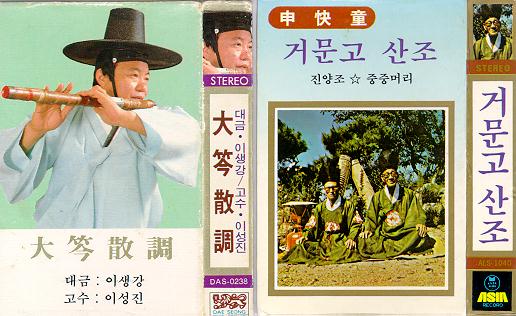
 These two cassettes were found in the back room of a major Korean bookstore in New York in 1987. They were remaindered, and the shopkeeper assured me they would never be re-ordered. Further searching has revealed that the two musicians appear on other existing recordings, but these two are out of print.
These two cassettes were found in the back room of a major Korean bookstore in New York in 1987. They were remaindered, and the shopkeeper assured me they would never be re-ordered. Further searching has revealed that the two musicians appear on other existing recordings, but these two are out of print.
Sanjo is the epitome of a "theme and variations" form. A melody is subjected to an amazing number of variations over the course of several movements. These movements are defined by their changdan (rhythmic phrase). Up to twelve changdan may be used, but four to six are more common. A single performance may last anywhere from 8 minutes to one hour. Sanjo began as a folk music form, but moved into the realm of royal patronage in the mid-19th century.
The instruments include:
taegum, a large transverse flute with a metal membrane near the mouthpiece. A skillful player can make it sound almost like a brass instrument.
changgo is the standard percussion instrument. It has two heads, and is played with a thin stick in one hand and a heavy beater in the other.
The performers on the Taegum Sanjo are Lee Seng-kang on taegum, accompanied by Lee Song-jin on changgo. The komungo player on the Komungo Sanjo is Shin Kwe-dong. The recordings were made in 1984.
There are many recordings of Korean traditional music on the market, although very few have complete sanjo performances like these.